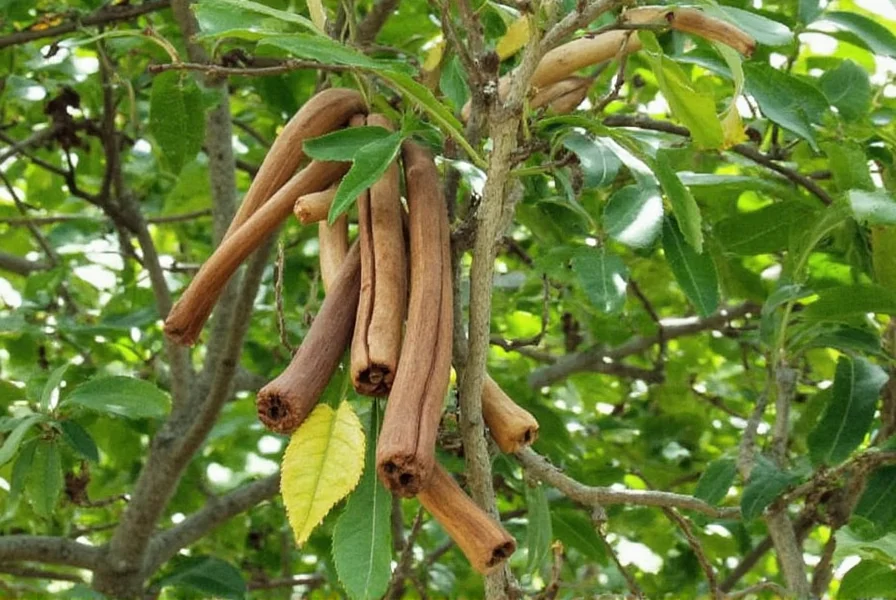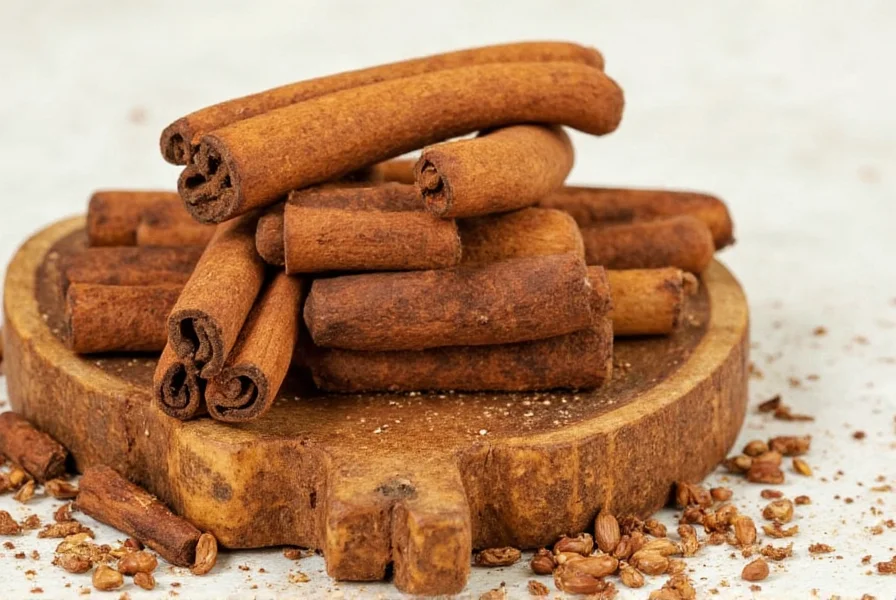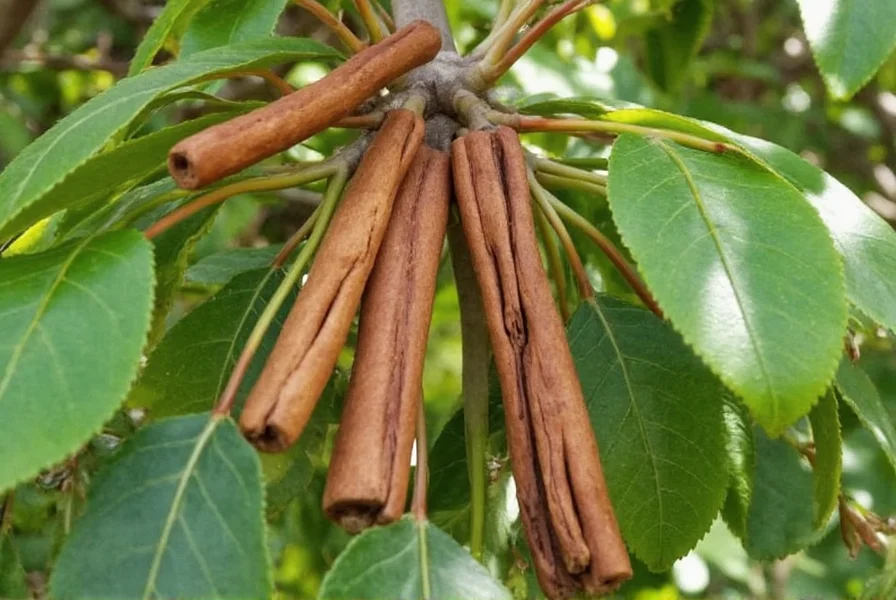The Ceylon cinnamon tree, scientifically known as Cinnamomum verum (meaning ‘true cinnamon’), represents the original cinnamon variety cherished since ancient times. Native exclusively to Sri Lanka (formerly Ceylon), this evergreen tree produces the delicate, complex spice distinguished by its light tan color, multiple-ply quills, and subtle sweet flavor profile. Understanding the authentic Ceylon cinnamon tree characteristics helps consumers differentiate it from the more common Cassia cinnamon found in most supermarkets.
Botanical Characteristics of Cinnamomum verum
Standing 30-50 feet tall in ideal conditions, the Ceylon cinnamon tree features smooth gray bark on mature trunks and distinctive reddish-brown shoots on younger growth. Its ovate leaves measure 2-7 inches long, displaying a glossy green upper surface with a distinctive pale underside. During spring, the tree produces small, inconspicuous yellow flowers in clusters, followed by small, dark purple berries containing a single seed.
What truly distinguishes the Ceylon cinnamon tree from other Cinnamomum species is its inner bark structure. When harvested, the bark naturally curls into thin, delicate quills that nest inside one another, creating the characteristic ‘cigar roll’ appearance. These multiple layers give Ceylon cinnamon its fragile texture compared to the single, thick, hard quill of Cassia cinnamon.

Historical Significance and Geographic Origin
The Ceylon cinnamon tree has been cultivated in Sri Lanka for over 2,000 years, with historical records showing ancient Egyptians using this precious spice. During the colonial era, Portuguese, Dutch, and British powers fiercely competed to control Sri Lanka's cinnamon trade, recognizing its immense economic value. Unlike Cassia cinnamon which grows wild across Asia, authentic Ceylon cinnamon comes exclusively from carefully cultivated Cinnamomum verum trees in Sri Lanka's wet zone regions.
This geographic exclusivity contributes significantly to Ceylon cinnamon's premium status. The specific combination of Sri Lanka's tropical climate, rainfall patterns, and soil composition creates ideal growing conditions that cannot be perfectly replicated elsewhere. While attempts have been made to grow Ceylon cinnamon trees in other tropical regions, the resulting bark typically lacks the distinctive flavor complexity of Sri Lankan-grown varieties.
Cultivation Requirements for Ceylon Cinnamon Trees
Growing a genuine Ceylon cinnamon tree requires specific tropical conditions that mimic its native Sri Lankan habitat. These trees thrive in USDA hardiness zones 10-12, needing consistent temperatures between 68-86°F (20-30°C) with high humidity levels. They cannot tolerate frost or extended dry periods.
Successful Ceylon cinnamon tree cultivation depends on several key factors:
| Growth Factor | Optimal Requirement | Consequences of Deviation |
|---|---|---|
| Soil Type | Well-draining sandy loam with pH 5.5-6.5 | Poor drainage causes root rot; alkaline soil stunts growth |
| Rainfall | 2,000-2,500 mm annually, evenly distributed | Dry periods reduce bark quality; excessive rain promotes fungal diseases |
| Sun Exposure | Partial shade (60-70% sunlight) | Full sun scorches leaves; too much shade reduces bark yield |
| Harvest Age | 2-year-old shoots for premium quality | Younger shoots lack sufficient bark; older bark becomes too woody |
Commercial growers typically plant Ceylon cinnamon trees from cuttings rather than seeds to maintain genetic consistency. The trees begin producing harvestable bark after two years, with peak production occurring between years 5-15. After this period, growers often coppice the trees (cutting them back to ground level) to stimulate new growth of optimal harvest quality.
Harvesting and Processing Techniques
The distinctive quality of Ceylon cinnamon depends entirely on traditional harvesting methods perfected over centuries in Sri Lanka. Harvesters select two-year-old shoots early in the morning when the bark contains maximum moisture. Using specialized tools, they make precise vertical cuts through the outer bark without damaging the valuable inner bark layer.
The processing involves several meticulous steps:
- Soaking the cut shoots in water to loosen the outer bark
- Removing the outer bark to expose the inner cinnamon layer
- Using a small knife to separate the inner bark from the woody core
- Layering multiple bark strips inside one another to form characteristic quills
- Air-drying the quills for 4-8 hours until they harden into their final form
This labor-intensive process explains why authentic Ceylon cinnamon commands higher prices than machine-processed Cassia. The entire operation must occur within hours of harvesting to preserve the delicate flavor compounds. Modern quality control measures now include coumarin testing, as Ceylon cinnamon naturally contains significantly less of this compound than Cassia varieties.
Ceylon Cinnamon Tree vs Cassia: Key Differences
Understanding how to identify a genuine Ceylon cinnamon tree versus Cassia varieties (primarily Cinnamomum cassia) proves essential for both consumers and growers. The most reliable identification method examines the bark structure:
- Ceylon cinnamon bark: Forms multiple thin layers (0.5-1 mm each) creating a soft, brittle quill that crumbles easily when bent
- Cassia cinnamon bark: Consists of a single thick layer (3-5 mm) forming a hard, dense quill that resists breaking
Additional distinguishing characteristics include:
- Color: Ceylon appears light tan to pale brown; Cassia shows a darker reddish-brown
- Flavor: Ceylon offers delicate, sweet notes with citrus undertones; Cassia delivers stronger, spicier heat
- Coumarin content: Ceylon contains 0.017g/kg; Cassia ranges from 2.1-6.97g/kg
- Leaf structure: Ceylon leaves have three prominent veins; Cassia shows a single central vein

Applications Beyond Culinary Use
While most consumers associate the Ceylon cinnamon tree with spice production, its applications extend far beyond culinary uses. Traditional Ayurvedic medicine has utilized various parts of the tree for centuries, with modern research beginning to validate some of these historical applications.
The essential oil extracted from Ceylon cinnamon bark contains cinnamaldehyde (50-60%), eugenol (5-10%), and linalool (2-5%), creating a complex chemical profile with multiple potential applications:
- Natural preservative in food and cosmetic products
- Antimicrobial agent in natural cleaning products
- Active ingredient in dental care formulations
- Traditional remedy for digestive support
Recent studies suggest potential health benefits associated with moderate Ceylon cinnamon consumption, particularly regarding blood sugar management and antioxidant activity. However, researchers emphasize that these benefits relate specifically to Ceylon cinnamon's unique chemical composition, which differs significantly from Cassia varieties.
Sustainable Cultivation Practices
As demand for authentic Ceylon cinnamon grows, sustainable cultivation practices become increasingly important. Traditional Sri Lankan growers have developed methods that maintain soil health while maximizing yield:
- Intercropping with shade-providing plants like coffee or cardamom
- Organic matter recycling through leaf litter management
- Water conservation techniques during dry periods
- Preserving genetic diversity through selective breeding
Certification programs like the Sri Lanka Spice Board's quality assurance system help maintain standards while supporting smallholder farmers. These initiatives ensure that increased global demand doesn't compromise the traditional knowledge and sustainable practices that have preserved Ceylon cinnamon quality for generations.
Frequently Asked Questions
How can I identify a genuine Ceylon cinnamon tree?
Look for smooth gray bark on mature trunks, reddish-brown young shoots, and ovate leaves with three prominent veins. The most reliable identifier is the inner bark structure when harvested - Ceylon cinnamon forms multiple thin layers creating delicate, easily crumbled quills, unlike Cassia's single thick layer.
What makes Ceylon cinnamon different from regular cinnamon?
Ceylon cinnamon (Cinnamomum verum) comes from a specific Sri Lankan tree species, while 'regular' cinnamon typically refers to Cassia (Cinnamomum cassia). Ceylon has multiple thin bark layers forming soft quills, lower coumarin content, and a more delicate, sweet flavor compared to Cassia's single thick, hard quill and stronger, spicier taste.
Can I grow a Ceylon cinnamon tree outside of Sri Lanka?
You can grow Ceylon cinnamon trees in tropical climates similar to Sri Lanka's (USDA zones 10-12), but the bark quality may differ. Successful cultivation requires consistent temperatures between 68-86°F, high humidity, well-draining acidic soil, and partial shade. The distinctive flavor profile depends on specific Sri Lankan growing conditions that are difficult to replicate exactly elsewhere.
Why is Ceylon cinnamon more expensive than other cinnamon?
Ceylon cinnamon commands higher prices due to its labor-intensive harvesting process, lower yield per tree, geographic exclusivity to Sri Lanka, and more complex flavor profile. The traditional method of hand-rolling multiple thin bark layers requires significant skill and time compared to machine-processed Cassia, which comes from a single thick bark layer.











 浙公网安备
33010002000092号
浙公网安备
33010002000092号 浙B2-20120091-4
浙B2-20120091-4